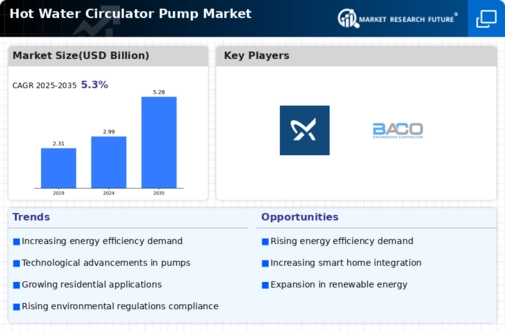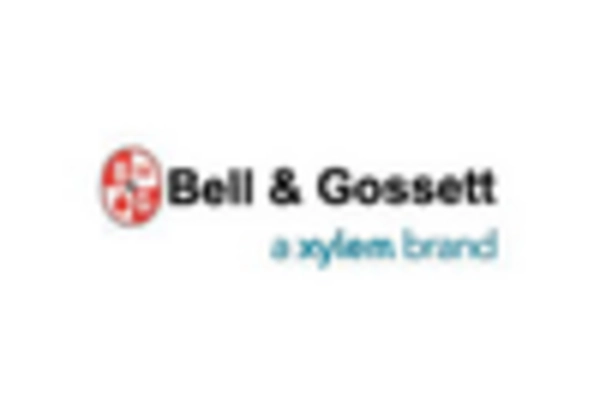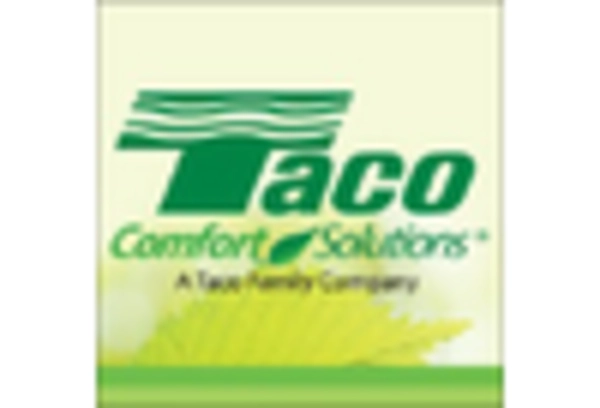-
Executive Summary
-
Introduction
-
Definition
-
Scope Of The Study
-
Assumptions
-
Market Structure
-
Research Methodology
-
Research Process
-
Primary Research
-
Secondary Research
-
Market Size Estimation
-
Forecast Model
-
Market Dynamics
-
Market Drivers
-
Market Inhibitors
-
Supply/Value Chain Analysis
-
Porter’s Five Forces Analysis
-
Global Hot Water Circulating Pump Market, By Type (Value)
-
Introduction
- Single Stage Pump
- Multi Stage Pump
-
Global Hot Water Circulating Pump Market, By Application (Value)
-
Introduction
- Residential
- Commercial
- Industrial
-
Global Hot Water Circulating Pump Market, By Region (Value)
-
Introduction
-
Global
- U.S.
- Canada
- Mexico
-
Europe
- U.K.
- France
- Germany
- Russia
- Italy
- Rest Of Europe
-
Asia-Pacific
- China
- Japan
- India
- South Korea
- Australia
- Rest Of Asia-Pacific
-
Middle East & Africa
- U.A.E
- Saudi Arabia
- Israel
- Turkey
- Egypt
- Rest Of Middle East & Africa
-
Latin America
- Brazil
- Argentina
- Peru
- Rest Of Latin America
-
Competitive Analysis
-
Introduction
-
Competitive Scenario
- Market Share Analysis
- Market Development Analysis
- Product/Service Benchmarking
-
Xylem, Inc
- Overview
- Product /Service Offering
- Strategy
-
Grundfos
- Overview
- Product /Service Offering
- Strategy
-
Flowserve Corporation
- Overview
- Product /Service Offering
- Strategy
-
Armstrong Fluid Technology Limited
- Overview
-
Product /Service Offering
- Strategy
-
7 Calpeda S.P.A
-
Overview
-
Product /Service Offering
-
Strategy
-
BacoEngineering.Com
- Overview
- Product /Service Offering
- Strategy
-
Taco
- Overview
- Product /Service Offering
- Strategy
-
AUMA Riester GmbH & Co. KG
- Overview
- Product /Service Offering
- Strategy
-
Emile Egger & Cie SA
- Overview
- Product /Service Offering
- Strategy
-
Saer Elettropompe SpA
- Overview
- Product /Service Offering
- Strategy
-
Appendix
-
List Of Secondary Sources
- List Of Associations
- List Of Magazines
- Linkedin Groups
- Paid Databases And Journals
-
List Of Tables
-
Market Synopsis 12
-
Published Patents On Hot Water Circulating Pump 32
-
Global Hot Water Circulating Pump Market, BY Application, 2023-2032 (USD Million) 41
-
Global Hot Water Circulating Pump Market, BY Type, 2023-2032 (USD Million) 45
-
Americas: Hot Water Circulating Pump MARKET, By Country, 2023-2032 (USD Million) 49
-
Americas: Hot Water Circulating Pump MARKET, By Application, 2023-2032 (USD Million) 50
-
Americas: Hot Water Circulating Pump MARKET, By Type, 2023-2032 (USD Million) 51
-
U.S.: Hot Water Circulating Pump MARKET, By Application, 2023-2032 (USD Million) 52
-
U.S.: Hot Water Circulating Pump MARKET, By Type, 2023-2032 (USD Million) 52
-
Canada: Hot Water Circulating Pump MARKET, By Application, 2023-2032 (USD Million) 53
-
Canada: Hot Water Circulating Pump MARKET, By Type, 2023-2032 (USD Million) 53
-
REST OF AMERICAS: Hot Water Circulating Pump MARKET, By Application, 2023-2032 (USD Million) 54
-
REST OF AMERICAS: Hot Water Circulating Pump MARKET, By Type, 2023-2032 (USD Million) 54
-
ASIA-PACIFIC: Hot Water Circulating Pump MARKET, By Country, 2023-2032 (USD Million) 56
-
ASIA-PACIFIC: Hot Water Circulating Pump MARKET, By Application, 2023-2032 (USD Million) 57
-
ASIA-PACIFIC: Hot Water Circulating Pump MARKET, By Type, 2023-2032 (USD Million) 58
-
U.K.: Hot Water Circulating Pump MARKET, By Application, 2023-2032 (USD Million) 59
-
China: Hot Water Circulating Pump MARKET, By Type, 2023-2032 (USD Million) 59
-
Japan: Hot Water Circulating Pump MARKET, By Application, 2023-2032 (USD Million) 60
-
Japan: Hot Water Circulating Pump MARKET, By Type, 2023-2032 (USD Million) 60
-
India: Hot Water Circulating Pump MARKET, By Application, 2023-2032 (USD Million) 61
-
India: Hot Water Circulating Pump MARKET, By Type, 2023-2032 (USD Million) 61
-
Rest Of ASIA-PACIFIC: Hot Water Circulating Pump MARKET, By Application, 2023-2032 (USD Million) 62
-
Rest Of ASIA-PACIFIC: Hot Water Circulating Pump MARKET, By Type, 2023-2032 (USD Million) 62
-
Europe, Middle East, And Africa: HOT WATER CIRCULATING PUMP MARKET, By Country, 2023-2032 (USD Million) 65
-
Europe, Middle East, And Africa: HOT WATER CIRCULATING PUMP MARKET, By Application, 2023-2032 (USD Million) 66
-
Europe, Middle East, And Africa: HOT WATER CIRCULATING PUMP MARKET, By Type,2023-2032 (USD Million) 67
-
U.K.: HOT WATER CIRCULATING PUMP MARKET, By Application, 2023-2032 (USD Million) 68
-
U.K.: HOT WATER CIRCULATING PUMP MARKET, By Type, 2023-2032 (USD Million) 68
-
Russia: HOT WATER CIRCULATING PUMP MARKET, By Application, 2023-2032 (USD Million) 69
-
Russia: HOT WATER CIRCULATING PUMP MARKET, By Type, 2023-2032 (USD Million) 69
-
France: HOT WATER CIRCULATING PUMP MARKET, By Application, 2023-2032 (USD Million) 70
-
France: HOT WATER CIRCULATING PUMP MARKET, By Type, 2023-2032 (USD Million) 70
-
Netherlands: Hot Water Circulating Pump MARKET, By Application, 2023-2032 (USD Million) 71
-
Netherlands: Hot Water Circulating Pump MARKET, By Type, 2023-2032 (USD Million) 71
-
Rest Of Europe, Middle East, And Africa: HOT WATER CIRCULATING PUMP MARKET, By Application, 2023-2032 (USD Million) 72
-
Rest Of Europe, Middle East, And Africa: HOT WATER CIRCULATING PUMP MARKET, By Type, 2023-2032 (USD Million) 72
-
Xylem, Inc: Product/Service Offerings 76
-
Grundfos: Product/Service Offerings 78
-
Flowserve Corporation: Product/Service Offerings 81
-
Armstrong Fluid Technology Limited: Product/Service Offerings 84
-
Calpeda S.P.A: Product/Service Offerings 87
-
BacoEngineering.Com: Product/Service Offerings 89
-
Taco: Product/Service Offerings 91
-
AUMA Riester GmbH & Co. KG: Product/Service Offerings 94
-
Emile Egger & Cie SA: Product/Service Offerings 95
-
Saer Elettropompe SpA: Product/Service Offerings 96
-
-
List Of Figures
-
COMPONENTS OF THE HOT WATER CIRCULATING PUMP 13
-
RESEARCH PROCESS OF MRFR 15
-
TOP DOWN & BOTTOM UP APPROACH 17
-
KEY BUYING CRITERIA OF HOT WATER CIRCULATING PUMPS 19
-
SOURCE: SECONDARY RESEARCH AND MRFR ANALYSIS 20
-
GLOBAL HOT WATER CIRCULATING PUMP MARKET, BY APPLICATION, 2032 (% SHARE) 40
-
GLOBAL HOT WATER CIRCULATING PUMP MARKET, BY APPLICATION, 2023-2032 (USD MILLION) 40
-
GLOBAL HOT WATER CIRCULATING PUMP MARKET, BY TYPE, 2032 (% SHARE) 44
-
GLOBAL HOT WATER CIRCULATING PUMP MARKET, BY TYPE, 2023-2032 (USD MILLION) 45
-
GLOBAL HOT WATER CIRCULATING PUMP MARKET, BY REGION, 2023-2032 (USD MILLION) 47
-
GLOBAL HOT WATER CIRCULATING PUMP MARKET, BY REGION, 2023-2032 (USD MILLION) 47
-
AMERICAS: HOT WATER CIRCULATING PUMP MARKET SHARE, BY COUNTRY, 2032 (% SHARE) 49
-
AMERICAS: HOT WATER CIRCULATING PUMP MARKET, BY APPLICATION, 2023-2032 (USD MILLION) 50
-
AMERICAS: HOT WATER CIRCULATING PUMP MARKET, BY TYPE, 2023-2032 (USD MILLION) 51
-
ASIA-PACIFIC: HOT WATER CIRCULATING PUMP MARKET, BY COUNTRY, 2032 (% SHARE) 55
-
ASIA-PACIFIC: HOT WATER CIRCULATING PUMP MARKET, BY APPLICATION, 2023-2032 (USD MILLION) 57
-
ASIA-PACIFIC: HOT WATER CIRCULATING PUMP MARKET, BY TYPE, 2023-2032 (USD MILLION) 58
-
EUROPE, MIDDLE EAST, AND AFRICA: HOT WATER CIRCULATING PUMP MARKET, BY COUNTRY, 2032 (% SHARE) 65
-
EUROPE, MIDDLE EAST, AND AFRICA: HOT WATER CIRCULATING PUMP MARKET, BY APPLICATION, 2023-2032 (USD MILLION) 66
-
EUROPE, MIDDLE EAST, AND AFRICA: HOT WATER CIRCULATING PUMP MARKET, BY TYPE, 2023-2032 (USD MILLION) 67
-
COMPETITORS BENCHMARKING 74
-
Xylem, Inc: TOTAL REVENUE, 2032 (USD MILLION) 75
-
Xylem, Inc: GEOGRAPHIC REVENUE, 2032 (%) 76
-
Xylem, Inc: SWOT ANALYSIS 77
-
Grundfos: SWOT ANALYSIS 79
-
Armstrong Fluid Technology Limited: TOTAL REVENUE (USD MILLION) 80
-
Armstrong Fluid Technology Limited: GEOGRAPHIC REVENUE, 2032 (%) 81
-
Armstrong Fluid Technology Limited: KEY DEVELOPMENTS, 2032 81
-
Armstrong Fluid Technology Limited: SWOT ANALYSIS 82
-
Calpeda S.P.A: TOTAL REVENUE (USD MILLION) 83
-
Calpeda S.P.A: GEOGRAPHIC REVENUE, 2032 (%) 84
-
Calpeda S.P.A: SWOT ANALYSIS 85
-
BacoEngineering.Com: TOTAL REVENUE (USD MILLION) 86

















Leave a Comment